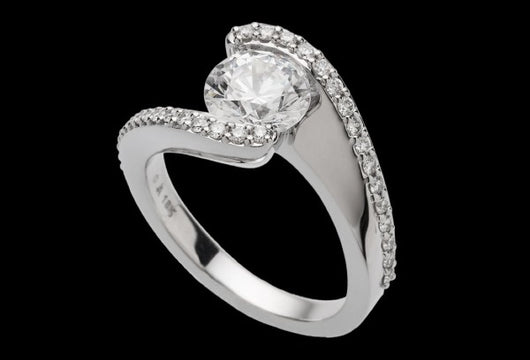Lab Diamond Rings: Platinum vs Gold – Which is the Best Choice?
Lab diamond rings have become a popular alternative to natural diamonds due to their ethical sourcing and affordability. When choosing a metal for your lab diamond ring, the debate between platinum vs gold is crucial. Both metals have their own advantages, but understanding their differences will help in making the right choice. This article explores the key aspects of lab diamond rings platinum vs gold to help you decide which one suits your preferences.
Durability and Strength of Lab Diamond Rings in Platinum vs Gold
When considering lab diamond rings, platinum vs gold is a major factor in terms of durability. Platinum is a dense and strong metal, making it highly resistant to wear and tear. Over time, platinum develops a patina, which many people find desirable as it enhances the vintage appeal of lab diamond rings. On the other hand, gold is softer and more prone to scratches, especially in its pure form. However, gold alloys such as 14k and 18k gold offer better durability. If longevity and strength are your priority, lab diamond rings in platinum vs gold lean more toward platinum as the better option.
Aesthetic Appeal of Lab Diamond Rings in Platinum vs Gold
The choice between lab diamond rings in platinum vs gold also depends on personal aesthetics. Platinum has a naturally white, silvery sheen that complements lab diamonds, enhancing their brilliance. Gold, however, comes in multiple shades, including yellow, white, and rose, offering a variety of style options. White gold is often compared to platinum due to its similar appearance, but it requires rhodium plating to maintain its brightness. Lab diamond rings in platinum vs gold ultimately depend on whether you prefer the classic and timeless look of platinum or the warm tones of gold.
Cost Comparison of Lab Diamond Rings in Platinum vs Gold
One of the most significant differences between lab diamond rings in platinum vs gold is the cost. Platinum is more expensive due to its density and rarity. It also weighs more than gold, adding to its price. Gold, on the other hand, is available in different karats, allowing for budget flexibility. Although platinum rings may have a higher initial cost, they require less maintenance over time compared to gold. When investing in lab diamond rings, platinum vs gold should be considered based on budget and long-term maintenance costs.
Maintenance and Care for Lab Diamond Rings in Platinum vs Gold
Proper maintenance is essential for preserving the beauty of lab diamond rings, and platinum vs gold each has different care requirements. Platinum is low maintenance since it does not tarnish or fade, but it does develop a patina that may require polishing. Gold, particularly white gold, needs regular re-plating to maintain its color and shine. Rose gold and yellow gold require occasional cleaning to keep their luster. When deciding between lab diamond rings in platinum vs gold, consider how much effort you are willing to put into maintenance.
Hypoallergenic Properties of Lab Diamond Rings in Platinum vs Gold
For individuals with sensitive skin, hypoallergenic properties play a key role in choosing lab diamond rings. Platinum is naturally hypoallergenic, making it ideal for people prone to metal allergies. In contrast, gold alloys may contain nickel or other metals that can cause irritation. White gold, in particular, often includes nickel, which can be problematic for sensitive skin. If allergies are a concern, lab diamond rings in platinum vs gold favor platinum as the safer option.
Resale Value of Lab Diamond Rings in Platinum vs Gold
The resale value of lab diamond rings is another factor to consider when comparing platinum vs gold. Platinum generally holds its value well due to its rarity and density. Gold, however, fluctuates in price depending on market conditions. While both metals retain some resale value, platinum is often more valuable in the long run. Investing in lab diamond rings in platinum vs gold should involve considering their potential resale worth over time.
Customization and Design Flexibility in Lab Diamond Rings in Platinum vs Gold
Lab diamond rings in platinum vs gold also differ in terms of design possibilities. Platinum is a denser metal, making intricate designs more durable. However, due to its hardness, platinum is more challenging to work with, which may limit certain design options. Gold is more malleable, allowing jewelers to create intricate and detailed settings for lab diamond rings. Whether you choose platinum or gold, both metals offer beautiful designs, but gold provides greater flexibility for custom jewelry.
Eco-Friendliness of Lab Diamond Rings in Platinum vs Gold
Sustainability is an essential factor when purchasing lab diamond rings, and platinum vs gold each has different environmental impacts. Platinum mining has a lower environmental footprint than gold mining due to the amount of ore required. However, recycled gold is a more eco-friendly choice, reducing the demand for new gold mining. Lab diamond rings in platinum vs gold can both be sustainable options, but choosing recycled metals enhances their environmental benefits.
Final Verdict: Lab Diamond Rings in Platinum vs Gold – Which One to Choose?
Ultimately, the decision between lab diamond rings in platinum vs gold depends on individual preferences, budget, and lifestyle. Platinum is the superior choice for durability, low maintenance, and hypoallergenic properties, making it ideal for long-term wear. Gold, on the other hand, offers a variety of colors and is more budget-friendly, providing a range of style choices. Both metals enhance the beauty of lab diamond rings, but your choice should align with your personal style and practical considerations.
Lab diamond rings are an excellent investment for those seeking ethical and beautiful jewelry. Whether you choose platinum or gold, understanding the key differences will help you make an informed decision. When comparing lab diamond rings in platinum vs gold, weigh the factors that matter most to you and select the perfect ring that reflects your style and values.







